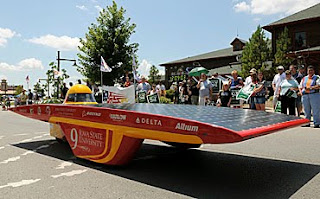Air conditioning powered by the sun, which bypasses the electricity grid?
Perfect for the Middle East.  It’s perfectly logical: When the thermostat rises on scorching hot days, the air conditioners kick in, causing a massive electricity surge that strains the grid. Summer blackouts and brownouts are already occurring in the US and in the Middle East. If mismanaged, they may cripple cities and damage local economies.
It’s perfectly logical: When the thermostat rises on scorching hot days, the air conditioners kick in, causing a massive electricity surge that strains the grid. Summer blackouts and brownouts are already occurring in the US and in the Middle East. If mismanaged, they may cripple cities and damage local economies.
In April 2006, for instance, parts of Texas experienced rolling blackouts lasting as long as five hours that were caused by air conditioner use. Blackouts from air con use in California were first experienced in early 2000 and continue to be a major priority on the California utility companies’ list of problems. Blackouts happen regularly in Israel in the summer; Lebanon suffers blackouts daily, and they loom in Kuwait as summer sets in.
Now Linum Systems a young Israeli solar air conditioning company claims it could have the answer. The company is ’solar cooling’ and heating homes using an old approach combined with their own new patents and technology.
The company may just be a year old, but already it is attracting interest. The non-profit California Israel Chamber of Commerce, identified Linum (based in Pardess Hana in northern Israel), as one of a dozen or so new clean-tech companies from Israel worth meeting. The chamber sent them to California a month ago to meet local investors, utilities companies and possible strategic partners.
Linum was founded in 2009 by solar energy entrepreneurs Yuval Berson and Amir Hirschfeld, both businessmen and engineer grads from the Technion – Israel Institute of Science who had worked for solar energy start-up D.i.S.P.
Green and simple
Expected to go commercial by 2012, Linum’s CEO Berson tells ISRAEL21c that the company, with a staff of less than 10, has yet to produce a formal prototype, but does have a proof of concept. When installed on a 3,000 square foot home, in say, Arizona or Texas, the return on investment (ROI) could be seen within about three years, he estimates.
Berson says the solution can curb high-energy demands during peak hours and peak seasons, adding that it makes good economic sense and is good for the environment.
‘Solar cooling’ is the process through which solar radiation uses hot water to create cooling systems with no need for electricity. It uses a solar thermal collector, not photovoltaics.
“Air conditioning, you may or may not know, is a huge problem and challenge in today’s energy world,” Berson explains. “Clearly there is a connection between hot and sunny days and the electricity load. If you look at heat waves, they are almost always associated with electricity crashes.”
According to the US Department of Energy, residential heating and cooling account for more than 50 percent of the energy use in a standard American home. “In California as much as a recent 30 or 40% rise in electricity use is solely air conditioning oriented, and it’s a major issue for utilities to solve,” Berson continues.
Private homes and offices
Based on the process of absorption, Linum aims to increase the efficiency of existing technologies, making them affordable for every mid-sized home in moderate to hot climates. The company says its air conditioner can cut the cooling, heating and water-heating electricity bills by as much as 85% on a hot sunny day and 40% annually.
“The home owner couldn’t care less where the energy comes from but wants ongoing service,” Berson tells ISRAEL21c. “Ours is capable of switching seamlessly from electricity to heating: If the sun starts to set we can add electricity to keep the same level of cooling. Or at night if you still need air conditioning, it performs as a very efficient electric air conditioner.
“We are looking at the large private village or small office as our target. From a 2,000 to a 3,000 square foot house. Generally, we are not looking at apartments that have a lot of power demands with very little roof space.”
“We decided it makes a lot of sense,” says Berson. “Heat from the sun and air conditioning is linked with peak hours at sunny times of the day. What’s unique about our idea is that it’s practical. In the past systems were big cumbersome and expensive.”
Making cool air from the heat of the sun is not a new idea, and Linum isn’t the only company in the business. The company has identified two major competitors: Swedish company ClimateWell which makes a good, but expensive absorption cooler, and Yazaki from Japan. “They use absorption chilling, an old technology that’s not cost effective,” states Berson. “We use a different way to convert heat to cool. We don’t use chemicals but standard refrigerates.” And no, not the ones that deplete the ozone, he promises.
Cooling in summer, heating in winter
How efficient the solar system can be is a function of how sunny the region is. As one moves north, more collectors will be needed to convert the sun’s heat into cooling systems in the summer and heating for the winter. A beautiful byproduct is continuous hot water.
The consumer would decide how many collectors to install. Typically, about 161 square feet will do. Linum would provide advice, through distributors and high-end installation companies, about what sort of collectors to use. Berson says that Linum will probably recommend hooking up to their unit with the flat panel collectors that have vacuum tubes and are common in colder climates. The Linum unit resembles the traditional air conditioning unit in use today. It can also be installed on the roof near the collectors.
Linum has enjoyed an undisclosed amount of seed investment from the Israel-based clean tech investment house Terra Venture Partners, and is looking for a strategic partner. The company is currently looking to California for investors, but feels it’s still too early to take on a business partner.
SOURCE
 Grabbing your camera as you're about to head out, only to find it's running low on power is one inconvenience that designer Weng Jie is hoping he can solve.
Grabbing your camera as you're about to head out, only to find it's running low on power is one inconvenience that designer Weng Jie is hoping he can solve. 




















